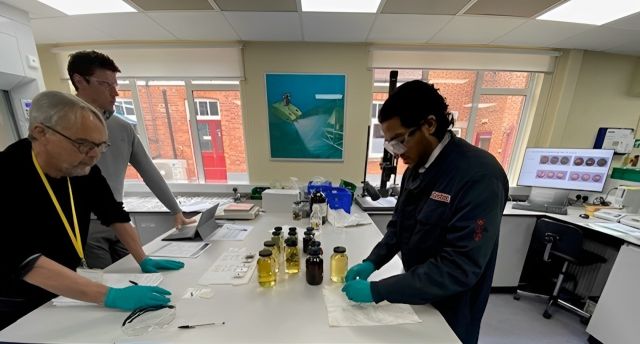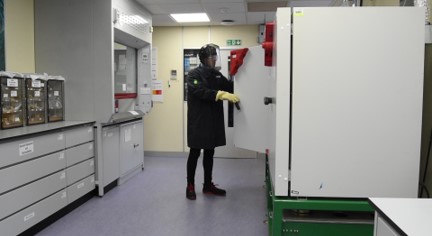
A third party witnesses API 17F metal testing of the Transaqua SP-HC fluid in the Pangbourne subsea lab. (Source: Castrol)
Even as all-electric subsea solutions claim headlines, traditional hydraulic solutions are still getting purchase orders.
“I'm a big fan of new technology, and I think where it can offer benefits, let's adopt it,” Alistair Mykura, senior technologist and original equipment manufacturer (OEM) liaison manager for Castrol Global Marine & Energy, told Hart Energy. “There are lots of benefits to all-electric in terms of reducing umbilical costs,” simplifying the top sides equipment and more.
“Don't get me wrong, there are massive benefits, but I always come back to why is it not more prevalent?”
In short, he said, the “shiniest” tech doesn’t always get signed contracts. As a case in point, he referenced the ongoing use of hydraulically-actuated systems to control subsea equipment.
“Hydraulic systems, they've been evolving for 40 years offshore. They're pretty well designed,” he said.
Ice prevention
One of the newest evolutions for hydraulic systems is a hydrate control version of Castrol’s original Transaqua SP fluid.
Transaqua SP was developed in 2014 and launched in 2016. The fluid is in use on more than 100 subsea trees with additional deployments planned. It features a system protection element to deter corrosion, a major issue offshore. The newly released hydrate control version, Transaqua SP-HC, is tailored for subsea production control systems for high-pressure deepwater gas projects.
The product is necessary, he said, as the same methods of preventing hydrates in flow lines don’t translate to control line application because there’s no option to inject more chemicals.
“You can't put in a low dose inhibitor,” Mykura said. “You have to somehow change the conditions that the line is in to get those hydrates to dissipate.”
Hydrate formation requires low temperatures, high pressures and the presence of methane or gas, and they need to mix at just the right conditions.
“If you do get a hydrate blockage, it's quite challenging to dislodge,” he said.
Mitigating that requires either adding a heavier, denser fluid to the control line and waiting for it to reach the blockage or simply waiting for conditions to change enough that the hydrate blockage dissipates on its own, he said.
Transaqua SP-HC “has the ability to withstand hydrate or inhibit hydrate formation in the production control lines. And whilst it is a relatively rare occurrence in terms of hydrates blocking the downhole lines to some of the valves, it can happen with the right environments,” Mykura said. “Certainly now that we're seeing more deepwater gas, more challenging environments in terms of depth temperatures, the risk of hydrates being formed as a result of the conditions is a real possibility, particularly with the water-based control fluids.”
He said the new fluid inhibits hydrates across a wide range of conditions, including lower temperatures and higher pressures. It can operate in temperatures of -58 F to 302 F.
“It is a pretty wide performance boundary, but we need it to be that way because you look at the gas wells that are being drilled today, and they're being bought online today, and they're fairly low temperatures now, ambient is below zero … the seabed temperature is very low. It is below zero in some cases,” he said. “You need to be able to have confidence and have enough safety margin in the subsea control fluid that you can operate in a hydrate free zone.”
According to the company, the fluid is suitable for Electro-Hydraulic Multiplex (EH-Mux) or direct hydraulic control systems in gas projects exceeding 20,000 psi, where entrained gas may contaminate control lines and create a risk of hydrates forming. The fluid can be used throughout production and workover control systems, including downhole subsurface safety valve (SSSV) and intelligent well completions.
It can also handle contaminates such as seawater.
“It's very similar to Transaqua SP, so you'll get the similar performance in terms of material performance, corrosion inhibition, but it'll also give you that hydrate control performance. So it is a big step forward in terms of chemistry and capability and the performance gains that you get from it, but it's still building on a really strong platform,” he said.
Mykura said the fluid, initially launched in December 2023, has already been adopted for two fields offshore Norway, with another field slated for later this year.
The fluid was designed in such a way that it could be retrofitted into hydraulic systems already using fluids from the Transaqua line.

Development
Castrol’s guiding standard for developing Transaqua SP-HC was API 17F, which mandates materials the fluid must be compatible with and temperatures and duration requirements. Mykura said the development team went beyond the standards set out by API 17F.
One of the trickier parts of development was finding a chemical composition that allowed fluid to evaporate while still protecting against corrosion, he said.
“That's where our chemist did something very clever,” he said. “We've got a certain chemistry platform. That means that if there is that particular situation where you have partially filled actuators, evaporation of the fluid into the space, you are not going to get corrosion of any of the more susceptible materials like your carbon steels and things like that.”
Mykura also worked with OEMs to qualify the fluids for use in their equipment.
The upshot of the qualification testing is the subsea control fluid, the number of materials that gets tested is in the hundreds. The goal: to ensure that the fluid won’t damage the materials it touches, he said.
“Once we've gone through the initial stages of just proving the fluid or the product out against API, we then go onto the OEM testing, which is a pretty lengthy program of work,” he said.
Fluids also need to meet environmental and sustainability requirements.
“We work very closely with the relative legislative bodies to ensure that the product as it is being developed meets the requirements for the regions where it's going to be sold. And again, that takes time because a lot of toxicology testing that needs to be done,” he said. “As you would imagine if these fluids are going to be discharged into the ocean, people want to be confident and ensure that it's not going to have a detrimental impact to the ecosystems.”
Recommended Reading
ONEOK, MPLX’s ‘Wellhead-to-Water’ Deal Dominates Permian NGL Race
2025-04-10 - The $1.75 billion ONEOK-MPLX deal reflects how midstream companies are going big in the petrochemicals sector.
South Bow Shuts Down Keystone Pipeline After Oil Release
2025-04-09 - South Bow Corp. reported a release of approximately 3,500 bbl near Fort Ransom, North Dakota, and it is evaluating the return-to-service plans.
Segrist: Permitting Outreach Efforts Land in Unusual Hands
2025-04-09 - Natural Allies group seeks to convince blue state citizens to embrace the natural gas infrastructure that they need. Some of the country’s largest natural gas and midstream companies back the group.
Exclusive: Kinder Morgan’s Fore on Pipeline Permitting Momentum in Past Year
2025-04-07 - Kinder Morgan’s Allen Fore, vice president of public affairs, delves into how the Trump administration’s initiatives to achieve energy dominance is a “game changer” for pipeline projects, in this Hart Energy Exclusive interview.
WhiteWater-Led NatGas Pipeline Traverse Reaches FID
2025-04-07 - The Traverse natural gas pipeline JV project will give owners optionality along the Gulf Coast.
Comments
Add new comment
This conversation is moderated according to Hart Energy community rules. Please read the rules before joining the discussion. If you’re experiencing any technical problems, please contact our customer care team.






